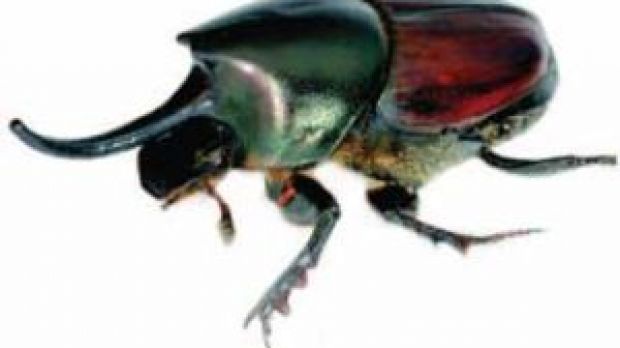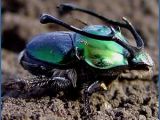A new study confirms a theory that dung beetles have evolved a trade-off between horn size and testes size. Male dung beetles of the genus Onthophagus have a larger size than females and a diverse array of horns. Sometimes, the horns may form 40% of the body length, depending on species.
The horns are used to battle against intruding males trying to enter the tunnels where they mate with females and larger horns will do better. But females often mate with more males. So, in order to outcompete other males' sperm, they also have to produce large shots of sperm. "They can't produce huge versions of both at the same time," said Douglas Emlen, a biologist at the University of Montana in Missoula.
"It is generally thought that the males that produce the most sperm are more likely to achieve a fertilization so, besides the horns, testicle capacity is important in competition between males too," says Emlen.
The problem is that during the metamorphosis from grub to adult, the developing organisms have very limited resources available. Entomologists have already found that horn size is negatively correlated to other traits such as eye, wing and antennae size.
Emlen and Leigh Simmons at the University of Western Australia in Crawley, experimentally stunted the development of horns in larvae of the species Onthophagus nigriventris (photo above).
Hornless males were larger and developed disproportionately large testes. "This study is the first solid experimental demonstration that adaptations to compete for mates trade-off with what it takes to compete for fertilizations," says Scott Pitnick at Syracuse University in New York, US. "Because of energetic constraints, you really can't be good at all things," he said.
Pitnick revealed a trade-off between brain and testes sizes in 300 different species of bat. Studying on other 25 Onthophagus species, the researchers did not find the same trade-off relationship. In fact, the species with the largest horns developed evolutionary strategies to buffer or protect the development of their testicles. Species with the highest degree of polygamy in females had also the largest testes. These species do not develop horns on the underside of their thoraxes, close to the testes, but on their heads.(photo bellow)
Horns close to testes might divert resources from the testes during the metamorphosis. "The testes truly are primary, and these beetles found a way to protect them," Emlen said.
"In species that don't have protected testes development, you don't get the really big horns."
"Trade-offs are fundamental to biology but they continue to surprise us, both in the forms they take, and in the myriad ways they can shape the evolution of organisms," says Emlen.

 14 DAY TRIAL //
14 DAY TRIAL // 
